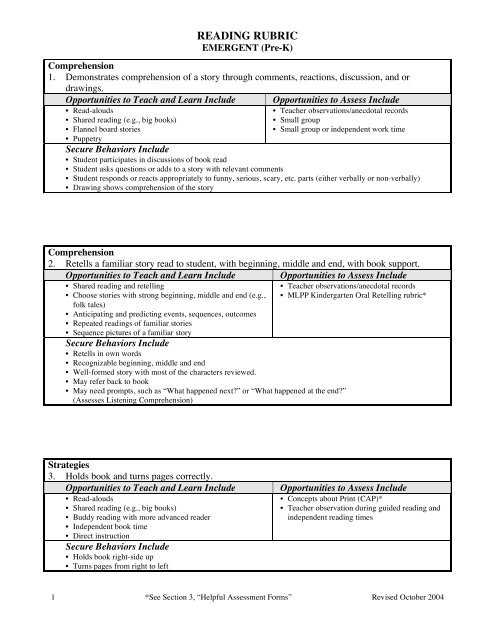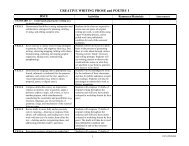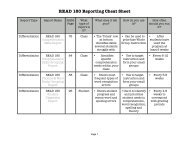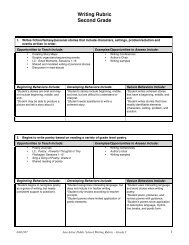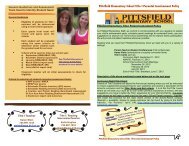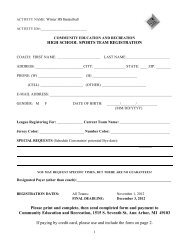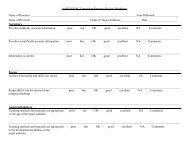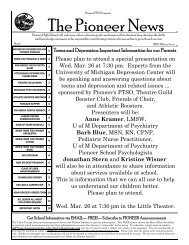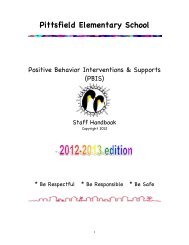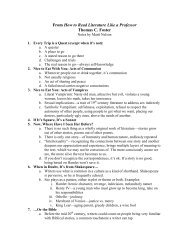(pre - K) - Reading Rubric
(pre - K) - Reading Rubric
(pre - K) - Reading Rubric
You also want an ePaper? Increase the reach of your titles
YUMPU automatically turns print PDFs into web optimized ePapers that Google loves.
READING RUBRIC<br />
EMERGENT (Pre-K)<br />
Com<strong>pre</strong>hension<br />
1. Demonstrates com<strong>pre</strong>hension of a story through comments, reactions, discussion, and or<br />
drawings.<br />
Opportunities to Teach and Learn Include Opportunities to Assess Include<br />
• Read-alouds<br />
• Shared reading (e.g., big books)<br />
• Flannel board stories<br />
• Puppetry<br />
• Teacher observations/anecdotal records<br />
• Small group<br />
• Small group or independent work time<br />
Secure Behaviors Include<br />
• Student participates in discussions of book read<br />
• Student asks questions or adds to a story with relevant comments<br />
• Student responds or reacts appropriately to funny, serious, scary, etc. parts (either verbally or non-verbally)<br />
• Drawing shows com<strong>pre</strong>hension of the story<br />
Com<strong>pre</strong>hension<br />
2. Retells a familiar story read to student, with beginning, middle and end, with book support.<br />
Opportunities to Teach and Learn Include Opportunities to Assess Include<br />
• Shared reading and retelling<br />
• Choose stories with strong beginning, middle and end (e.g.,<br />
folk tales)<br />
• Anticipating and <strong>pre</strong>dicting events, sequences, outcomes<br />
• Repeated readings of familiar stories<br />
• Sequence pictures of a familiar story<br />
Secure Behaviors Include<br />
• Retells in own words<br />
• Recognizable beginning, middle and end<br />
• Well-formed story with most of the characters reviewed.<br />
• May refer back to book<br />
• May need prompts, such as “What happened next?” or “What happened at the end?”<br />
(Assesses Listening Com<strong>pre</strong>hension)<br />
• Teacher observations/anecdotal records<br />
• MLPP Kindergarten Oral Retelling rubric*<br />
Strategies<br />
3. Holds book and turns pages correctly.<br />
Opportunities to Teach and Learn Include<br />
• Read-alouds<br />
• Shared reading (e.g., big books)<br />
• Buddy reading with more advanced reader<br />
• Independent book time<br />
• Direct instruction<br />
Secure Behaviors Include<br />
• Holds book right-side up<br />
• Turns pages from right to left<br />
Opportunities to Assess Include<br />
• Concepts about Print (CAP)*<br />
• Teacher observation during guided reading and<br />
independent reading times<br />
1 *See Section 3, “Helpful Assessment Forms” Revised October 2004
READING RUBRIC<br />
EMERGENT (Pre-K)<br />
Strategies<br />
4. Demonstrates left to right directional movement.<br />
Opportunities to Teach and Learn Include<br />
• Shared reading (e.g., big books)<br />
• Buddy reading with more advanced reader<br />
• Interactive writing<br />
• Guided reading<br />
• Direct instruction<br />
Secure Behaviors Include<br />
• <strong>Reading</strong> left to right, with return sweep<br />
• Reads left page before right page<br />
Opportunities to Assess Include<br />
• Concepts about Print (CAP)*<br />
• Observations during guided reading and<br />
independent reading time<br />
Strategies<br />
5. Identifies 15-20 of 54 letter names (includes a, g).<br />
Opportunities to Teach and Learn Include<br />
• Tracing letters with finger while saying letter (in alphabet<br />
books)<br />
• <strong>Reading</strong> alphabet charts<br />
• Interactive writing<br />
• Using magnetic letters, clay, sand trays, finger paints, letter<br />
stamps<br />
• Activities with students’ names.<br />
Secure Behaviors Include<br />
• Identifies letter names when <strong>pre</strong>sented in random order<br />
Opportunities to Assess Include<br />
• Letter Identification checklist*<br />
Strategies<br />
6. Recognizes familiar print such as names or signs.<br />
Opportunities to Teach and Learn Include<br />
• Instructional use of:<br />
- classroom labels - familiar names<br />
- signs, logos - word walls<br />
- familiar rhymes and songs - pocket chart stories<br />
- print created during daily interactive writing<br />
• Regular opportunities to “Read the Room”<br />
Secure Behaviors Include<br />
• Child can recognize 5-6 examples of print in the classroom<br />
• Over time, student routinely recognizes names/words in context, e.g.,<br />
- signs in the community (STOP, in/out, exit, Kroger, etc.)<br />
- product labels (Kleenex, Jell-O, etc.)<br />
- room signs/ labels (sink, door, kitchen center, sand table, etc.)<br />
- words from familiar books, charts, word wall<br />
- other students’ names<br />
Opportunities to Assess Include<br />
• Teacher observations/anecdotal records<br />
• Observation Survey Word List*<br />
2 *See Section 3, “Helpful Assessment Forms” Revised October 2004
READING RUBRIC<br />
EMERGENT (Pre-K)<br />
Listening and Speaking<br />
7. Communicates wants and needs verbally.<br />
Opportunities to Teach and Learn Include<br />
• Class meetings/community circles<br />
• Center time<br />
• Play times<br />
Secure Behaviors Include<br />
• Student tells others when happy, sad or angry<br />
• Student stays on topic during short conversation/discussion<br />
• Student tells an adult of his needs<br />
Opportunities to Assess Include<br />
• Teacher observations/anecdotal records<br />
Listening and Speaking<br />
8. Has vocabulary to name common objects and discuss everyday experiences.<br />
Opportunities to Teach and Learn Include<br />
Opportunities to Assess Include<br />
• Discussions during/following read-alouds and shared<br />
reading<br />
• Show and tell<br />
• Class meetings/community circles<br />
• Discussion of pictures<br />
• Guessing games with common objects<br />
Secure Behaviors Include<br />
• Student tells others about things heard and/or experienced<br />
• Student uses specific language (the red truck) rather than general (that thing)<br />
• Student provides two sentences to describe a picture<br />
• Teacher observations/anecdotal records<br />
3 *See Section 3, “Helpful Assessment Forms” Revised October 2004
READING RUBRIC<br />
DEVELOPING (Kindergarten)<br />
Com<strong>pre</strong>hension<br />
1. Reads books with <strong>pre</strong>dictable text. (End-of-year guided reading target: Level C*)<br />
Opportunities to Assess Include<br />
• Shared reading (e.g., big books, charts, sentence strips, cut<br />
up poems, songs on transparencies, stories written during<br />
interactive writing) (See Ap<strong>pre</strong>nticeship in Literacy, p. 32.)<br />
• Guided reading (See Guided <strong>Reading</strong> and Word Matters,<br />
pp. 230 and 233)<br />
• Daily opportunities for independent reading of “just right”<br />
books<br />
• Encourage repeated readings of familiar books<br />
• For end-of-year target, see Guided <strong>Reading</strong>, p. 119.<br />
• Developmental <strong>Reading</strong> Assessment (DRA)<br />
(available in every building)<br />
(DRA Level s 1-2; Rigby PM Assessment<br />
Benchmark Level A = Fountas/Pinnell Guided<br />
<strong>Reading</strong> Level A )<br />
• Rigby PM Benchmark Assessment Kit<br />
(available in every building)<br />
(Fountas/Pinnell Guided reading Level C =<br />
Rigby PM Assessment Benchmark Levels 3-4<br />
• <strong>Reading</strong> conferences<br />
• Running records*<br />
• Teacher observations/anecdotal records<br />
Secure Behaviors Include<br />
• After a book introduction and an opportunity to look over the book, student routinely reads Level C book with 95-<br />
100% accuracy and instructional level com<strong>pre</strong>hension or with 90-94% accuracy and independent or instructional<br />
level com<strong>pre</strong>hension.<br />
November March June<br />
Secure A A C<br />
Com<strong>pre</strong>hension<br />
2. Memorizes pattern books, poems and familiar books.<br />
Opportunities to Teach and Learn Include<br />
• Shared reading (e.g., big books)<br />
• Read-alouds<br />
• Rhyming books<br />
• Fingerplays, poems and songs<br />
• Daily opportunities for students to read big books, familiar<br />
books and posted poems and charts<br />
Secure Behaviors Include<br />
• Student reads/recites pattern books, poems, and familiar books.<br />
Opportunities to Assess Include<br />
• Independent reading<br />
• Teacher observation<br />
4 *See Section 3, “Helpful Assessment Forms” Revised October 2004
READING RUBRIC<br />
DEVELOPING (Kindergarten)<br />
Com<strong>pre</strong>hension<br />
3. Retells a familiar story read to student with beginning, middle and end, without book support.<br />
Opportunities to Teach and Learn Include Opportunities to Assess Include<br />
• Choose stories with strong beginning, middle and end (e.g.,<br />
folk tales)<br />
• Give many experiences in anticipating and <strong>pre</strong>dicting events<br />
in stories<br />
• Give students practice in sequencing pictures of a familiar<br />
story<br />
• Fold paper into thirds: after reading first third of book, talk<br />
about what happened, have children draw; do same for<br />
middle and end<br />
• Model and have students practice retelling in small groups<br />
• Model and provide students with opportunities to do puppet<br />
and flannel board stories<br />
• Encourage students to tell narratives about personal<br />
experiences; identify beginning, middle and end of narrative<br />
• Model and encourage repeated readings of familiar books<br />
Secure Behaviors Include<br />
• Retells in own words without referring back to the book<br />
• May need prompts, such as “What happened next?” or “What happened at the end?”<br />
• Recognizable beginning, middle and end<br />
• Well-formed story with most of the characters reviewed<br />
• Kindergarten Oral Retelling rubric*<br />
• Retells story in own words, without book; may<br />
need prompts<br />
• Listen to student’s retelling with puppets or<br />
flannelboard characters.<br />
Com<strong>pre</strong>hension<br />
4. Identifies main idea and two facts of informational book read to child without book support.<br />
Opportunities to Teach and Learn Include Opportunities to Assess Include<br />
• Read-alouds (at least once a week selection should be<br />
informational)<br />
• Shared reading (e.g., big books)<br />
• Books from science, social studies kits<br />
• Create charts, webs or other graphic organizers to help<br />
students learn to organize information<br />
• Group discussions<br />
• Direct teaching of structure of informational texts (compare<br />
with story structure)<br />
Secure Behaviors Include<br />
• Information is taken from the text<br />
• Information is related to the main idea<br />
• Teacher observation<br />
• Small group<br />
• Whole group: Identify one student to assess<br />
after reading text selection to the class<br />
• May use prompts such as “What was the main<br />
idea of this book was about?” “What are two<br />
things that you learned about ____ from this<br />
book?”<br />
• Make sure text is about information students are<br />
not likely already to know before reading the<br />
book (check on prior knowledge)<br />
5 *See Section 3, “Helpful Assessment Forms” Revised October 2004
READING RUBRIC<br />
DEVELOPING (Kindergarten)<br />
Com<strong>pre</strong>hension<br />
5. Demonstrates personal connection to stories read or heard through comments, reactions,<br />
discussion and/or drawings.<br />
Opportunities to Teach and Learn Include Opportunities to Assess Include<br />
• Read-alouds about school, families, pets, other familiar<br />
topics<br />
• Shared reading (e.g., big books)<br />
• Guided reading<br />
• Think-alouds when teacher models making text-to-self<br />
and/or text-to-text connections<br />
• Class discussions with connections to self, other texts<br />
• Class books of innovations on other stories<br />
• Resources: Mosaic of Thought (Chapter 4) and Strategies<br />
that Work (Chapter 6 and page 265)<br />
Secure Behaviors Include<br />
• Students identify how pictures or text remind them of their own life<br />
• Students can identify how current text reminds them of other texts<br />
Strategies<br />
6. Identifies 20-46 of 54 letter names.<br />
Opportunities to Teach and Learn Include<br />
• Tracing letters with finger while saying letter (e.g., in<br />
alphabet books)<br />
• <strong>Reading</strong> alphabet charts, books<br />
• Using magnetic letters, clay, sand trays, finger paints, letter<br />
stamps (e.g., ABC center)<br />
• Letter Bingo<br />
• Daily interactive writing<br />
• Shared reading (e.g., letter framing in big books)<br />
• Word work activities (e.g., those found in Phonics Lessons<br />
and Word Matters)<br />
• Student name activities<br />
Secure Behaviors Include<br />
• Student identifies letter names when <strong>pre</strong>sented with letters in random order.<br />
Strategies<br />
7. Identifies 46-54 of 54 letter names.<br />
Opportunities to Teach and Learn Include<br />
• Tracing letters with finger while saying letter (e.g., in<br />
alphabet books)<br />
• <strong>Reading</strong> alphabet charts, books<br />
• Using magnetic letters, clay, sand trays, finger paints, letter<br />
stamps (e.g., ABC center)<br />
• Letter Bingo<br />
• Shared reading (e.g., letter framing in big books)<br />
• Daily interactive writing<br />
• Word work activities (e.g., those found in Word Matters)<br />
• Activities focused on student names<br />
Secure Behaviors Include<br />
• Student identifies letter names when <strong>pre</strong>sented with letters in random order<br />
• Teacher may use such prompts as “Does this<br />
remind you of anything that ever happened to<br />
you?” or “Does this remind you of another book<br />
we have read?”<br />
• Anecdotal notes taken during discussions or as<br />
listening to student conversations<br />
Opportunities to Assess Include<br />
• Letter Identification Checklist*<br />
Opportunities to Assess Include<br />
• Letter Identification Checklist*<br />
6 *See Section 3, “Helpful Assessment Forms” Revised October 2004
Strategies<br />
8. Rhymes and plays with words.<br />
Opportunities to Teach and Learn Include<br />
READING RUBRIC<br />
DEVELOPING (Kindergarten)<br />
• Daily read-alouds<br />
• Shared reading (e.g., big books)<br />
• Rhyming books<br />
• Fingerplays, rhymes, poems, chants and songs<br />
• Cloze procedures (cover word; what would rhyme with __?)<br />
• Activities taken from Phonics Lessons<br />
• Partner game with rhyming words (have sets of rhyming<br />
words; pass out randomly; students find rhyming partner)<br />
• Provides experiences with segmenting and blending sounds<br />
Opportunities to Assess Include<br />
• Assessing Phonemic Awareness*<br />
Secure Behaviors Include<br />
• Given a word, the child can generate a rhyme (may be nonsense) with 80% accuracy<br />
• Substitutes sounds (“Willoughby, Wolloughby, Woo”) for rhyming patterns<br />
Strategies<br />
9. Uses information from pictures to construct meaning.<br />
Opportunities to Teach and Learn Include<br />
• Shared reading (e.g., big books)<br />
• Guided reading<br />
• Analyzing pictures, conjecturing what is going on what<br />
might happen next.<br />
• Doing picture walks to <strong>pre</strong>dict what text is about.<br />
Secure Behaviors Include<br />
• Student relates information that is communicated through pictures.<br />
• Student forms a story while attending to pictures.<br />
Opportunities to Assess Include<br />
• Teacher observations and anecdotal records<br />
• Student shares story related to his own drawings<br />
or other artwork/illustrations.<br />
Strategies<br />
10. Uses a sight word vocabulary of 10-15 words in reading/writing contexts.<br />
Opportunities to Teach and Learn Include Opportunities to Assess Include<br />
• Word walls<br />
• Shared reading (e.g., big books, wall charts, sentence strips)<br />
• Guided reading<br />
• Read song/fingerplay/poetry charts<br />
• Morning message<br />
• Daily interactive writing (e.g., making class books that are<br />
available for students to read)<br />
• Leveled book boxes readily available in the room<br />
• Daily opportunities for independent reading (“just right”<br />
texts) and writing, (e.g., journal writing)<br />
• <strong>Reading</strong> the Room<br />
• Word work (e.g., activities from Phonics Lessons and Word<br />
Matters)<br />
• Sight word Bingo<br />
• Running Records*<br />
• Writing Vocabulary Observation Sheet*<br />
• Student writing samples<br />
• Observation Survey Word Test*<br />
• MLPP Sight Word/Decodable Word List<br />
• Teacher observation/anecdotal records<br />
• High frequency word lists (e.g., Harris Word<br />
List* or San Diego Quick Assessment)<br />
NOTE: The target is reading and writing words in<br />
context; therefore, assessment should not be<br />
limited to a check of words in isolation.<br />
Secure Behaviors Include<br />
• There are at least 10-15 sight words that student can read automatically when reading connected texts.<br />
• There are at least 10-15 sight words that student can write independently when composing messages<br />
7 *See Section 3, “Helpful Assessment Forms” Revised October 2004
READING RUBRIC<br />
DEVELOPING (Kindergarten)<br />
Strategies<br />
11. Uses at least 20 sounds in reading/writing contexts.<br />
Opportunities to Teach and Learn Include<br />
• Shared reading (e.g., big books)<br />
• Guided reading<br />
• Direct instruction in the use of phonetic cues for identifying<br />
unknown words<br />
• Direct instruction in phonemic segmentation<br />
• Daily interactive writing (e.g., writing about class<br />
experiences and observations, creating class lists and books)<br />
• Daily opportunities for independent writing (e.g., as in<br />
Journals)<br />
• Activities such as those found in Phonics Lessons<br />
• Have children find pictures in magazines that start with a<br />
particular sound<br />
• Have children create alphabet books<br />
• Encourage phonetic spelling in children’s work (while<br />
teaching conventional spelling during word work time)<br />
Secure Behaviors Include<br />
• Student demonstrates knowledge of 20 initial sounds in reading or writing contexts<br />
Opportunities to Assess Include<br />
• Hearing and Recording Sounds in Words*<br />
• Checklists<br />
• Writing samples<br />
• Running Records<br />
• Beginning and Ending Sound check*<br />
Strategies<br />
12. Uses 1:1 correspondence to track print.<br />
Opportunities to Teach and Learn Include<br />
• Shared reading, modeling that message is in the print,<br />
demonstrating one-to-one correspondence between spoken<br />
and written words<br />
• <strong>Reading</strong> sticks/pointers<br />
• Framing words<br />
• Cutting apart sentences, matching words to sentences<br />
• Counting, graphing words on each page<br />
• Provide opportunities for student to read with older/more<br />
advanced reader, with younger student following along in<br />
the text with her finger<br />
Secure Behaviors Include<br />
• Student uses finger to track text with 1-to-1 correspondence<br />
Opportunities to Assess Include<br />
• Concepts about Print (CAP)*<br />
• Running Records*<br />
• Teacher observation/anecdotal records<br />
8 *See Section 3, “Helpful Assessment Forms” Revised October 2004
READING RUBRIC<br />
DEVELOPING (Kindergarten)<br />
Strategies<br />
13. Uses print and illustrations to problem solveº text.<br />
Opportunities to Teach and Learn Include<br />
• Modeling during shared reading (e.g., big books)<br />
• Guided reading<br />
• Picture walks to <strong>pre</strong>dict what text will be about<br />
• Direct instruction in the use of pictures to help identify<br />
unknown words<br />
• Encouraging children to use illustrations to <strong>pre</strong>dict what<br />
might happen next<br />
Opportunities to Assess Include<br />
Developmental <strong>Reading</strong> Assessment (DRA)<br />
(available in every building)<br />
(Fountas/Pinnell Guided <strong>Reading</strong> Level C =<br />
DRA Level 3)<br />
• Student/teacher conferences<br />
• Teacher observation/anecdotal during guided<br />
reading<br />
• Running records*<br />
º NOTE: “Problem solving text” refers to (1)<br />
identifying the word and (2) com<strong>pre</strong>hending its<br />
meaning.)<br />
Secure Behaviors Include<br />
• Student uses illustrations to <strong>pre</strong>dict meaning as well as particular words, with level C (end-of-year target) books.<br />
Listening and Speaking<br />
14. Gives detailed description of needs, wants and events.<br />
Opportunities to Teach and Learn Include<br />
• Class meetings/discussions<br />
• Recess<br />
• Modeling through role plays, dramatization<br />
• Some children will need ongoing direct instruction to meet<br />
this outcome<br />
Secure Behaviors Include<br />
• Student uses words to communicate what s/he wants, needs and what happened<br />
Opportunities to Assess Include<br />
• Teacher observations/anecdotal records<br />
Listening and Speaking<br />
15. Listens to others without interrupting.<br />
Opportunities to Teach and Learn Include<br />
• Class meetings/discussions<br />
• Small group discussions<br />
• Direct teaching and demonstration of conversational turntaking.<br />
• Direct teaching of active listening techniques.<br />
Secure Behaviors Include<br />
• Student shows attentiveness through his body language when others are speaking.<br />
• Student makes relevant comments about what others have to say.<br />
• Student asks questions of others for clarification or for more information.<br />
Opportunities to Assess Include<br />
• Teacher observations/anecdotal records<br />
9 *See Section 3, “Helpful Assessment Forms” Revised October 2004
READING RUBRIC<br />
BEGINNING (Grade 1)<br />
Com<strong>pre</strong>hension<br />
1. Reads and com<strong>pre</strong>hends books at Level I (End-of-year guided reading target*)<br />
Opportunities to Teach and Learn Include Opportunities to Assess Include<br />
• Shared reading (e.g., big books, charts, sentence strips, cut<br />
up poems, songs on transparencies, stories written during<br />
interactive writing) (See Ap<strong>pre</strong>nticeship in Literacy, p. 32.)<br />
• Daily opportunities for independent reading of “just right”<br />
books<br />
• Peer/buddy reading<br />
• Guided reading (See Guided <strong>Reading</strong> and Word Matters,<br />
pp. 230 and 233)<br />
• Encourage repeated readings<br />
• For end-of-year target, see Guided <strong>Reading</strong>, p. 125.<br />
• Developmental <strong>Reading</strong> Assessment (DRA)<br />
(available in every building)<br />
• Rigby PM Benchmark Assessment Kit<br />
(available in every building)<br />
(Fountas/Pinnell Guided reading Level I =<br />
Rigby PM Assessment Benchmark Level 15-16.)<br />
• Running records*<br />
• <strong>Reading</strong> logs<br />
• <strong>Reading</strong> conferences<br />
• Audiotaping/videotaping (for portfolio)<br />
Secure Behaviors Include<br />
• After a book introduction and an opportunity to look over the book, student routinely reads Level I book with 95-<br />
100% accuracy and instructional level com<strong>pre</strong>hension or with 90-94% accuracy and independent or instructional<br />
level com<strong>pre</strong>hension.<br />
November March June<br />
Secure D G I<br />
Com<strong>pre</strong>hension<br />
2. Reads aloud with fluency and ex<strong>pre</strong>ssion.<br />
Opportunities to Teach and Learn Include<br />
• Read-alouds (discussing and modeling fluent and<br />
ex<strong>pre</strong>ssive reading)<br />
• Shared reading (e.g., mini-lesson with a big book)<br />
• Partner reading<br />
• Do “echo reading” to work on fluency and ex<strong>pre</strong>ssion<br />
• Do readers’ theater and choral reading to work on fluency<br />
• Author’s chair (students practice reading by selecting<br />
familiar print to share with an outside audience)<br />
• Listening centers<br />
• Audio tape student reading and provide feedback as you<br />
listen to it together<br />
• See Word Matters, p. 10 and Guided <strong>Reading</strong>, p. 150<br />
Secure Behaviors Include<br />
• Reads smoothly, using appropriate ex<strong>pre</strong>ssion and pauses<br />
• Reads primarily in larger meaningful phrases<br />
• Few word-by-word slow downs or re-readings for problem solving<br />
• Ex<strong>pre</strong>ssive inter<strong>pre</strong>tation is evident throughout the reading<br />
• Shows awareness of punctuation and uses it for phrasing, pacing and meaning<br />
Opportunities to Assess Include<br />
• Oral <strong>Reading</strong> Fluency <strong>Rubric</strong>*<br />
• Running records*<br />
• <strong>Reading</strong> conferences<br />
• Teacher observations/anecdotal records<br />
10 *See Section 3, “Helpful Assessment Forms” Revised October 2004
READING RUBRIC<br />
BEGINNING (Grade 1)<br />
Com<strong>pre</strong>hension<br />
3. Retells stories independently read to reflect sequence, setting, characters, problem and resolution.<br />
Opportunities to Teach and Learn Include Opportunities to Assess Include<br />
• Read-alouds<br />
• Shared reading (e.g., big book)<br />
• Guided reading<br />
• Use of graphic organizers to model story elements included<br />
in retelling<br />
• Use of dramatizations, puppets, flannel boards and story<br />
boards<br />
• 5-finger retelling<br />
• Modeling during interactive writing<br />
• Students’ Oral or Written Retelling <strong>Rubric</strong>,<br />
grades one and two*<br />
• 5-finger retelling<br />
• Use of story map, web or story board<br />
Secure Behaviors Include<br />
• Retelling contains a clear restatement of most story elements (main characters, setting, problem, major events, and<br />
resolution) and their connection to one another.<br />
Com<strong>pre</strong>hension<br />
4. Identifies main idea and two supporting details of informational text read independently.<br />
Opportunities to Teach and Learn Include Opportunities to Assess Include<br />
• Read-alouds (at least once a week selection should be<br />
informational)<br />
• Shared reading (e.g., big books, transparencies, Time for<br />
Kids)<br />
• Guided reading of informational books<br />
• Use of leveled trade books related to science and social<br />
studies units<br />
• Create charts, webs or other graphic organizers to help<br />
students learn to organize information<br />
• Group discussions<br />
• Direct teaching of structure of informational texts (compare<br />
with story structure)<br />
Secure Behaviors Include<br />
• Information is taken from the text<br />
• Information is related to the main idea<br />
• Student may refer back to the book<br />
• Teacher observation in the following settings<br />
- <strong>Reading</strong> conferences<br />
- Class discussions<br />
- Guided reading<br />
• May use prompts such as “What was the main<br />
idea of this book was about?” “What are two<br />
things that you learned about ____ from this<br />
book?”<br />
• NOTE: Make sure text is about information<br />
students are not likely already to know before<br />
reading the book (check on prior knowledge)<br />
11 *See Section 3, “Helpful Assessment Forms” Revised October 2004
READING RUBRIC<br />
BEGINNING (Grade 1)<br />
Com<strong>pre</strong>hension<br />
5. Makes connections to other authors, books and personal experiences.<br />
Opportunities to Teach and Learn Include Opportunities to Assess Include<br />
• Read-alouds (e.g., including topics familiar to students)<br />
• Shared reading (e.g., big books)<br />
• Guided reading<br />
• Think-alouds with teacher modeling making text-to-self<br />
and/or text-to-text connections<br />
• Class discussions with connections to self, other texts<br />
• Graphic organizers (comparing/contrasting, Venn diagrams,<br />
webs)<br />
• Science and social studies kit books<br />
• Comparing fiction/nonfiction books (e.g., Steck/Vaughn<br />
fiction/nonfiction series)<br />
• Comparing different versions of same story<br />
• <strong>Reading</strong> several books by the same author<br />
• <strong>Reading</strong> several books of the same genre or topic<br />
• Resources: Mosaic of Thought (Chapter 4) and Strategies<br />
that Work (Chapter 6 and page 265)<br />
• Graphic organizers<br />
• Teacher observations/anecdotal records made<br />
during class discussions, reading conferences or<br />
as listening to student conversations<br />
• Class or small group discussions<br />
• Student written responses<br />
• Mosaic of Thought, p. 228<br />
Secure Behaviors Include<br />
• Student makes connections supported by the text:<br />
- identifies how text reminds him/her of his/her own life<br />
- identifies how current text reminds him/her of other texts or authors<br />
• Teacher may use such prompts as “Does this remind you of anything that ever happened to you?” or “Does this<br />
remind you of another book we have read?”<br />
Strategies<br />
6. Uses visual cues.<br />
Opportunities to Teach and Learn Include<br />
• Shared reading (e.g., big books)<br />
• Guided reading<br />
• Cloze activities<br />
• Using think-alouds and modeling<br />
• Placing key words on word wall<br />
• Word work (e.g., from Phonics Lessons and Word Matters)<br />
• Modeling and guided practice during interactive writing<br />
• Direct teaching of this cueing strategy<br />
Opportunities to Assess Include<br />
• Running records* (M/S/V<br />
[Meaning/Structure/Visual] analysis)<br />
(See Guided <strong>Reading</strong>, p. 89 and Word Matters,<br />
pp. 113 and 222)<br />
• <strong>Reading</strong> conferences<br />
• Teacher observations/anecdotal records<br />
Secure Behaviors Include<br />
• Uses knowledge of letter-sound relationships to <strong>pre</strong>dict, then checks for accuracy, i.e.,<br />
- Connects knowledge of the visual features of letters and words with the way letters and words sound when<br />
spoken as sources of information to read and self-correct.<br />
• Easily recalls sight words as they appear in text.<br />
12 *See Section 3, “Helpful Assessment Forms” Revised October 2004
READING RUBRIC<br />
BEGINNING (Grade 1)<br />
Strategies<br />
7. Uses structure cues (e.g., word roots, <strong>pre</strong>fixes, suffixes, word chunks).<br />
Opportunities to Teach and Learn Include Opportunities to Assess Include<br />
• Shared reading (e.g., big books)<br />
• Guided reading<br />
• Cloze activities<br />
• Using think-alouds and modeling<br />
• Placing key words on word wall<br />
• Word work (e.g., from Phonics Lessons and Word Matters)<br />
• Modeling and guided practice during interactive writing<br />
• Direct teaching of this cueing strategy<br />
• Running records* (M/S/V<br />
[Meaning/Structure/Visual] analysis)<br />
(See Guided <strong>Reading</strong>, p. 89, Phonics Lessons<br />
and Word Matters, pp. 113 and 222)<br />
• <strong>Reading</strong> conferences<br />
• Teacher observations/anecdotal records<br />
Secure Behaviors Include<br />
• Uses structure (syntax) of language to <strong>pre</strong>dict, then checks for accuracy, i.e.,<br />
- Uses implicit knowledge of the way the grammar of the language works as sources of information to read and<br />
self-correct.<br />
• Uses knowledge of known words to get to unknown words (e.g., “I know that the word is ‘start’ because I see the<br />
word ‘art’.”)<br />
• Uses knowledge of syntax to read with phrasing.<br />
Strategies<br />
8. Uses meaning cues.<br />
Opportunities to Teach and Learn Include<br />
• Shared reading (e.g., big books)<br />
• Guided reading<br />
• Cloze activities<br />
• Using think-alouds and modeling<br />
• Direct teaching of this cueing strategy<br />
Opportunities to Assess Include<br />
• Running records* (M/S/V<br />
[Meaning/Structure/Visual] analysis)<br />
(See Guided <strong>Reading</strong>, p. 89 and Word Matters,<br />
pp. 113 and 222)<br />
• <strong>Reading</strong> conferences<br />
• Teacher observations/anecdotal records<br />
Secure Behaviors Include<br />
• Uses context of sentence to <strong>pre</strong>dict, then checks for accuracy.<br />
- Uses story background, information from a picture and meaning in the sentence as sources of information to read<br />
and self-correct.<br />
Strategies<br />
9. Self corrects miscues that affect meaning.<br />
Opportunities to Teach and Learn Include<br />
• Shared <strong>Reading</strong><br />
• Guided reading<br />
• Mini-lessons and think-alouds to regularly models this<br />
strategy<br />
• Encourage student to use multiple sources of information to<br />
self-correct (direct instruction and modeling)<br />
Opportunities to Assess Include<br />
• Running records* (M/S/V<br />
[Meaning/Structure/Visual] analysis)<br />
(See Guided <strong>Reading</strong>, p. 89 and Word Matters,<br />
pp. 113 and 222)<br />
• <strong>Reading</strong> conferences<br />
• Teacher observations/anecdotal records<br />
Secure Behaviors Include<br />
• Notices mismatches, searches for additional information, makes another attempt that results in a match that restores<br />
meaning.<br />
• Cross-checks one source of information against another (Does it look right? Sound right? Make sense?)<br />
• Self-corrects two out of three errors that affect meaning.<br />
13 *See Section 3, “Helpful Assessment Forms” Revised October 2004
READING RUBRIC<br />
BEGINNING (Grade 1)<br />
Strategies<br />
10. Uses multiple strategies automatically as needed to problem solve text.<br />
Opportunities to Teach and Learn Include Opportunities to Assess Include<br />
• Shared reading (e.g., for instruction, modeling and guided<br />
practice)<br />
• Think-alouds<br />
• Mini-lessons<br />
• Guided reading<br />
• Daily independent reading with “just right” books<br />
• Cloze activities<br />
• See Guided <strong>Reading</strong>, p 149<br />
Secure Behaviors Include<br />
• Student automatically uses appropriate/successful cues to word solve.<br />
• Student knows which strategy to use to help himself.<br />
• Running records* (M/S/V<br />
[Meaning/Structure/Visual] analysis)<br />
(See Guided <strong>Reading</strong>, p. 89 and Word Matters,<br />
pp. 113 and 222)<br />
• <strong>Reading</strong> conferences<br />
• Teacher observations/anecdotal records<br />
Listening and Speaking<br />
11. Responds to others using complete sentences.<br />
Opportunities to Teach and Learn Include<br />
• Class meetings<br />
• Book sharing<br />
• Author’s chair<br />
• Direct instruction<br />
• Provide opportunity for students to have conversation with<br />
others.<br />
Secure Behaviors Include<br />
• Child takes turns in conversation setting.<br />
Opportunities to Assess Include<br />
• Teacher observations/anecdotal records<br />
Listening and Speaking<br />
12. Uses questions and statements in appropriate contexts.<br />
Opportunities to Teach and Learn Include Opportunities to Assess Include<br />
• Class meetings<br />
• Book sharing<br />
• Author’s chair<br />
• Direct instruction<br />
• Teacher observations/anecdotal records<br />
Secure Behaviors Include<br />
• Differentiates between questions and statements, e.g., When asked “Are there any questions?” responds with an<br />
appropriate questions. When are asked “Are there any comments?” responds with an appropriate statement?”<br />
• Asks appropriate questions of guest speakers and peers<br />
14 *See Section 3, “Helpful Assessment Forms” Revised October 2004
READING RUBRIC<br />
EXPANDING (Grade 2)<br />
Com<strong>pre</strong>hension<br />
1. Reads, with fluency and com<strong>pre</strong>hension, Level M books. (End-of-year guided reading target*)<br />
Opportunities to Teach and Learn Include Opportunities to Assess Include<br />
• Guided reading (See Guided <strong>Reading</strong> and Word Matters,<br />
pp. 230 and 233)<br />
• Literature circles<br />
• Book discussions<br />
• Shared reading<br />
• Daily opportunities for independent reading of “just right”<br />
books<br />
• Peer/buddy reading<br />
• Encourage repeated readings<br />
• Encourage reading books in a series (e.g., Henry and<br />
Mudge, Arthur, Nate-the-Great, Cam Jansen series)<br />
• Listening centers<br />
• For end-of-year target, see Guided <strong>Reading</strong>, p. 129.<br />
• Rigby PM Benchmark Kit (Fountas/Pinnell<br />
Guided <strong>Reading</strong> Level M = Rigby Benchmark<br />
Kit Level 22.)<br />
• Running records*<br />
• Teacher observation/Anecdotal records<br />
• <strong>Reading</strong> logs<br />
• <strong>Reading</strong> response journals (rubric*)<br />
• <strong>Reading</strong> conferences<br />
• Audiotaping/videotaping (for portfolio)<br />
Secure Behaviors Include<br />
• After a book introduction and an opportunity to look over the book, student routinely reads Level M book with 95-<br />
100% accuracy and instructional level com<strong>pre</strong>hension or with 90-94% accuracy and independent or instructional<br />
level com<strong>pre</strong>hension.<br />
November March June<br />
Secure J L M<br />
Com<strong>pre</strong>hension<br />
2. Reads and com<strong>pre</strong>hends a variety of materials with guidance (e.g., folktales, poetry, biography,<br />
informational material, historical fiction, mystery).<br />
Opportunities to Teach and Learn Include Opportunities to Assess Include<br />
• Read-alouds<br />
• Shared reading (e.g., big books, charts, transparencies)<br />
• Guided reading<br />
• Genre wheels<br />
• Direct teaching of text structures<br />
• Science and social studies kits<br />
• <strong>Reading</strong> logs<br />
• Checklists<br />
• Genre wheels<br />
• Teacher observations/Anecdotal records<br />
• <strong>Reading</strong> conferences<br />
• <strong>Reading</strong> response journals<br />
Secure Behaviors Include<br />
• Demonstrates ability to read and com<strong>pre</strong>hend 5-6 different genres.<br />
• Uses strategies appropriate for nature of material read, e.g.,<br />
- reads novels from beginning to end<br />
- rereads poetry to focus on the rhythm of the language, phrasing for meaning<br />
- is selective about informational text, reading sections that address questions the reader brings to the task<br />
15 *See Section 3, “Helpful Assessment Forms” Revised October 2004
READING RUBRIC<br />
EXPANDING (Grade 2)<br />
Com<strong>pre</strong>hension<br />
3. Makes inferences that can be supported by the text.<br />
Opportunities to Teach and Learn Include<br />
• Read-alouds to model and provide whole-group practice<br />
• Guided reading<br />
• Literature circles<br />
• Junior Great Books<br />
• Graphic organizers to help students understand text<br />
structure (e.g., sequencing, cause and effect)<br />
• Directly teaching inferencing strategies (See Mosaic of<br />
Thought, Chapter 8 and Strategies that Work, Chapter 8.)<br />
• Make certain that students have opportunities to make<br />
<strong>pre</strong>dictions – backed by evidence – in other content areas<br />
(e.g., math [also estimations], science investigations, social<br />
studies)<br />
Opportunities to Assess Include<br />
• Ask students questions such as, <strong>pre</strong>dicting<br />
“What will happen next?” and “Why do you<br />
think that?, “Why did the character do that?”<br />
• Rigby PM Benchmark Kit, com<strong>pre</strong>hension<br />
questions on the back of the Running Record<br />
sheet<br />
• Teacher observations in the following settings:<br />
– Individual reading conferences<br />
– Literature Circles<br />
– Classroom discussions<br />
– Guided reading groups<br />
– Junior Great Book groups<br />
• Response Journals<br />
Secure Behaviors Include<br />
• Student uses background knowledge and information from the text.<br />
• Student develops <strong>pre</strong>dictions, inter<strong>pre</strong>tations, and/or conclusions, using evidence from the text to support their<br />
thinking.<br />
Com<strong>pre</strong>hension<br />
4. Identifies topic, main ideas and supporting details of informational text read by student.<br />
Opportunities to Teach and Learn Include Opportunities to Assess Include<br />
• Read-alouds (at least once a week selection should be<br />
informational)<br />
• Shared reading (e.g., big books, transparencies, Time for<br />
Kids, National Geographic)<br />
• Use of resources such as the internet, informational videos<br />
• Guided reading of informational books<br />
• Use of leveled trade books related to science and social<br />
studies units<br />
• Create charts, webs or other graphic organizers to help<br />
students learn to organize information<br />
• Group discussions<br />
• Direct teaching of structure of informational texts (compare<br />
with story structure)<br />
Secure Behaviors Include<br />
• Information is taken from the text.<br />
• Details are related to the main idea.<br />
• Student may refer back to the book<br />
• Teacher observation in the following settings<br />
- <strong>Reading</strong> conferences<br />
- Class discussions<br />
- Guided reading<br />
• May use prompts such as “What was the main<br />
idea of this book was about?” “What are two<br />
things that you learned about ____ from this<br />
book?”<br />
• NOTE: Make sure text is about information<br />
students are not likely already to know before<br />
reading the book (check on prior knowledge)<br />
16 *See Section 3, “Helpful Assessment Forms” Revised October 2004
READING RUBRIC<br />
EXPANDING (Grade 2)<br />
Com<strong>pre</strong>hension<br />
5. Makes connections, with guidance, to books and personal experiences.<br />
Opportunities to Teach and Learn Include Opportunities to Assess Include<br />
• Read alouds (Choose stories with obvious connections)<br />
• Guided reading<br />
• Literature circles<br />
• Junior Great Books<br />
• Graphic organizers (e.g., charts and webs)<br />
• Folk tales unit (social studies)<br />
• Trade books in science kit<br />
• Think-alouds with teacher modeling making text-to-self<br />
and/or text-to-text connections<br />
• Class or small group brainstorms connections<br />
• Behavior-over-time-graphs<br />
• Comparing fiction/nonfiction books (e.g., Steck/Vaughn<br />
fiction/nonfiction series)<br />
• Comparing different versions of same story<br />
• <strong>Reading</strong> several books by the same author<br />
• <strong>Reading</strong> several books of the same genre or topic<br />
• Resources: Mosaic of Thought (Chapter 4) and Strategies<br />
that Work (Chapter 6 and page 265)<br />
• Rigby PM Benchmark Kit, com<strong>pre</strong>hension<br />
questions on the back of the Running Record<br />
sheet<br />
• Teacher observations in the following settings:<br />
- Individual reading conferences<br />
- Literature Circles<br />
- Classroom discussions<br />
- Guided reading groups<br />
- Junior Great Books groups<br />
• Student written responses<br />
Secure Behaviors Include<br />
• Relates background knowledge/experience to their reading of a text<br />
• Makes connections between and among authors and texts read, seeing similarities and differences<br />
• Teacher may use such prompts as “Does this remind you of anything that ever happened to you?” or “Does this<br />
remind you of another book we have read?”<br />
Strategies<br />
6. Uses multiple strategies automatically as needed (using book levels J-M).<br />
Opportunities to Teach and Learn Include Opportunities to Assess Include<br />
• Shared reading (e.g., for instruction, modeling and guided<br />
practice)<br />
• Think-alouds<br />
• Mini-lessons<br />
• Guided reading<br />
• Daily independent reading with “just right” books<br />
• Cloze activities<br />
• See Guided <strong>Reading</strong>, p 149<br />
Secure Behaviors Include<br />
• Independently checks to make sure that reading makes sense, sounds right, looks right.<br />
• Automatically uses multiple strategies to figure out words while focusing on meaning<br />
• Simultaneously processes meaning, structural and visual cues.<br />
• Running records* (M/S/V<br />
[Meaning/Structure/Visual] analysis)<br />
(See Guided <strong>Reading</strong>, p. 89 and Word Matters,<br />
pp. 113 and 222)<br />
• Analysis of running record<br />
• <strong>Reading</strong> conferences<br />
• Teacher observations/anecdotal records<br />
17 *See Section 3, “Helpful Assessment Forms” Revised October 2004
READING RUBRIC<br />
EXPANDING (Grade 2)<br />
Com<strong>pre</strong>hension<br />
7. Uses tables of contents, captions, glossaries and indices to locate and gather information.<br />
Opportunities to Teach and Learn Include Opportunities to Assess Include<br />
• Shared reading of books in science and social studies kits<br />
• Shared reading of informational periodicals<br />
• Guided reading of material containing the above graphic<br />
aids<br />
• Make class books with Table of Contents and Index<br />
• Play “search and find” games, e.g.,<br />
- Who can find the page with information about ______?<br />
- On what page does chapter 3 begin?<br />
• Teacher observation in the following settings:<br />
- Individual reading conferences<br />
- Guided reading sessions<br />
- Class discussions<br />
- While gathering information for written reports<br />
and projects<br />
• Student has authentic opportunities to use table of<br />
contents and indices to locate information he/she<br />
has a genuine interest in finding.<br />
Secure Behaviors Include<br />
• Student locates information with the help of a table of contents.<br />
• Student locates information with the help of an index.<br />
• Student accurately gathers information communicated in captions and the graphics they accompany.<br />
• Student uses a glossary to determine the meaning of a word or phrase.<br />
• Student uses these tools on numerous occasions<br />
Strategies<br />
8. Effectively and efficiently analyzes longer words.<br />
Opportunities to Teach and Learn Include<br />
• 30 minutes of word work , daily (Word Matters, Phonics<br />
Lessons)<br />
• Use mini-lessons to teach strategies for solving words<br />
(Word Matters, p. 152, Phonics Lessons)<br />
• Use a structured, but flexible, word study system that builds<br />
on what students already know (See Word Matters, p. 171,<br />
Phonics Lessons)<br />
• Teach about syllables, root words, <strong>pre</strong>fixes and suffixes<br />
Opportunities to Assess Include<br />
• Running records*<br />
• Individual reading conferences<br />
• Writing samples<br />
• Teacher observation/anecdotal records<br />
Secure Behaviors Include<br />
• Uses understanding of word structure to identify multi-syllabic words.<br />
• Figures out partially known words by making connections, analogies and using context.<br />
• Sounds out part of a word and links the part to known words or parts of words.<br />
• Is able to use the dictionary as a tool.<br />
• Student demonstrates this skill by reading fluently in meaningful phrases.<br />
Listening and Speaking<br />
9. Develops and elaborates ideas clearly, using supportive and relevant details.<br />
Opportunities to Teach Include:<br />
• Class meetings/community circles<br />
• Explaining solutions and thinking (EDM)<br />
• Generating and answering questions<br />
• Literature circles<br />
Secure Behaviors Include<br />
• Explains own ideas clearly.<br />
• Supports main idea with related details.<br />
• Ideas ex<strong>pre</strong>ssed are related to the topic being discussed<br />
Opportunities to Assess Includes:<br />
• Teacher observation in the following settings:<br />
- Individual reading conferences<br />
- Guided reading sessions<br />
- Literature circles<br />
- Community circles/class meetings<br />
- Class discussions<br />
- Students sharing information with a peer<br />
18 *See Section 3, “Helpful Assessment Forms” Revised October 2004


